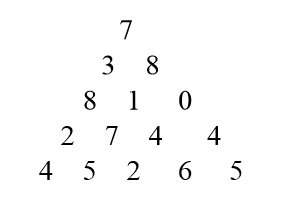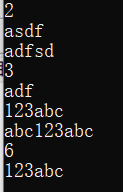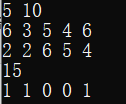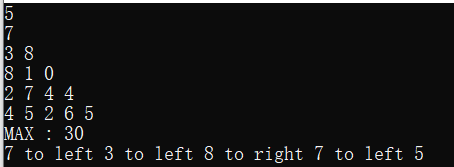1, Four basic steps of dynamic planning:

2, Common methods of dynamic programming:
(1) Bottom up solution:
The most common dp algorithm derives the optimal solution of the problem with the second smaller scale from the initial value of dp, records it in the array, and then continuously expands the problem scale to find the sub problem with a larger scale. Each time the current problem is solved, the previous solution will be used. Therefore, save the previous solutions to avoid repeated calculations for the same sub problem.
(2) Top down solution:
Also known as memorandum act. It can be considered as an optimized recursive algorithm. That is, open up an array space. In the recursive process, check whether the problem has been solved. If the solution has been obtained earlier, there is no need for recursion, and the solution of the sub problem can be obtained directly. Otherwise, it can be solved recursively. In essence, it is the recursive implementation of the former algorithm. In the real solution, it also solves the sub problem with the smallest scale first, and then expands the problem scale in turn. Moreover, because the program is recursive, it has to pay additional program running cost.
3, Examples of dynamic planning to solve problems:
(1) Digital triangle problem

Find a path from the top to the bottom in the number triangle to maximize the sum of the numbers on the path. Each step on the path can only go down left or right. Just find the maximum sum and the path. The number of rows of triangle is greater than 1, less than or equal to 100, and the number is 0 - 99
Input format:
five // Represents the number of rows of a triangle Next, enter the triangle
7
3 8
8 1 0
2 7 4 4
4 5 2 6 5
Maximum output path required
sample input
5
7
3 8
8 1 0
2 7 4 4
4 5 2 6 5
sample output
MAX : 30
7 to left 3 to left 8 to right 7 to left 5
analysis:
The state transition equation of digital triangle problem is dp[i][j]=max(dp[i-1][j-1],dp[i-1][j])+a[i][j]; dp[i][j] means the maximum possible value to (i,j). According to the analysis, only the two points in the upper left corner (i-1, j-1) and the upper right corner (i-1.j) may reach the current point (i,j). Take the largest of them and add a[i][j] to get dp[i][j]. At the same time, record s [i] [J] to indicate which direction dp[i][j] is obtained from. Initialize dp[k][0], dp[k][k], s[k][0], s[k][k] Where 0 < = k < n. Traverse the bottom dp[n-1][k] to find the maximum value. The path can be obtained by s[i][j] recursive solution.
code:
#include<iostream>
using namespace std;
int a[100][100];
int dp[100][100];
int s[100][100];
void init(int n){//dp initialization
dp[0][0]=a[0][0];
for(int i=1;i<n;i++){
dp[i][i]=dp[i-1][i-1]+a[i][i];
dp[i][0]=dp[i-1][0]+a[i][0];
s[i][i]=-1;
s[i][0]=1;
}
}
int solve(int n,int &t){//The optimal solution of each position is obtained in turn
init(n);
for(int i=1;i<n;i++){
for(int j=1;j<i;j++){
dp[i][j]=max(dp[i-1][j-1],dp[i-1][j])+a[i][j];
if(dp[i-1][j-1]>dp[i-1][j])s[i][j]=-1;//Select with s[i][j] record
else s[i][j]=1;
}
}
int max=dp[n-1][0];
t=0;
for(int i=1;i<n;i++){
if(dp[n-1][i]>max){
max=dp[n-1][i];
t=i;
}
}
return max;//Returns the lowest optimal solution
}
void print(int i,int j){//Using s[i][j] to reconstruct the optimal solution
if(i==0){
cout<<a[i][j]<<' ';
return ;
}
if(s[i][j]>0){
print(i-1,j);
cout<<"to left"<<' ';
}
else{
print(i-1,j-1);
cout<<"to right"<<' ';
}
cout<<a[i][j]<<' ';
}
int main(){
int n;
cin>>n;
for(int i=0;i<n;i++){
for(int j=0;j<=i;j++){
cin>>a[i][j];
}
}
int t;
cout<<"MAX : "<<solve(n,t)<<endl;
print(n-1,t);
return 0;
}
/*
5
7
3 8
8 1 0
2 7 4 4
4 5 2 6 5
*/Operation results:
(2) Longest common subsequence problem:
Given two sequences X={x1,x2,..., xm} and Y={y1,y2,..., yn}, find the longest common subsequence of X and y.
Input:
The first line gives an integer n (0 < n < 100) indicating the number of data groups to be tested. Next, each group of data has two rows, which are two groups of strings to be tested. The length of each string shall not be greater than 1000.
Output:
Each group of test data outputs an integer representing the length of the longest common subsequence, and outputs the longest common subsequence at the same time.
sample input
2
asdf
adfsd
123abc
abc123abc
sample output
3
adf
6
123abc
analysis:
The state transition equation of the longest common subsequence is:
if(s1[i-1]==s2[j-1])
dp[i][j]= dp[i-1][j-1]+1;
else
dp[i][j]=max(dp[i-1][j], dp[i][j-1]);
The physical meaning of dp[i][j] is: the longest common subsequence of s1[0] to s1[i] and s2[0] to s2[j]. The dp process is to view the last bit of the two strings. If they are the same, it can be considered that the lengths of the two strings subtract the last bit, and then dp[i][j]= dp[i-1][j-1]+1;
If the last bit is different, the optimal solution shall be selected according to the two situations, and the last bit of s1 string or s2 shall be removed before judgment (the removal will not affect the final solution). Finally, if the size of the problem is reduced to a string length of 0, the longest common subsequence is also 0. Therefore, the initial condition of dp can be set (the global variable is not initialized). Because the optimal solution is to be output, it is necessary to record whether s1 string or the end of s2 string is removed when the last bit is not equal. Use 1, 2 and 3 to represent the status of three options, which exist in b[i][j]. The LCS function is solved recursively and the result is output.
code:
#include<iostream>
using namespace std;
string s1;
string s2;
int dp[1000][1000];
int b[1000][1000];//Selection during recording dp process
int solve(int i,int j){//Calculate the optimal value
if(s1[i-1]==s2[j-1]){
b[i][j]=1;
return dp[i-1][j-1]+1;
}
else{
if(dp[i-1][j]>dp[i][j-1]){
b[i][j]=2;
return dp[i-1][j];
}
else{
b[i][j]=3;
return dp[i][j-1];
}
}
}
void LCS(int i,int j){//1 2 3 represents three different dp modes
if(b[i][j]==1){
LCS(i-1,j-1);
cout<<s1[i-1];
}
if(b[i][j]==2){
LCS(i-1,j);
}
if(b[i][j]==3){
LCS(i,j-1);
}
}
int main(){
int N;
cin>>N;
while(N--){
cin>>s1;
cin>>s2;
for(int i=1;i<=s1.length();i++){
for(int j=1;j<=s2.length();j++){
dp[i][j]=solve(i,j);//dp
}
}
cout<<dp[s1.length()][s2.length()]<<endl;//Output optimal value
LCS(s1.length(),s2.length());//Construct optimal solution
cout<<endl;
}
return 0;
}
/*
2
asdf
adfsd
123abc
abc123abc
*/Operation results:

(3) 0-1 knapsack problem
Given n items and a backpack. The weight of item i is wi, its value is vi, and the capacity of the backpack is W. Q: how to select the items loaded into the backpack to maximize the total value of the items loaded into the backpack?
Input: the first line has two positive integers n and W,n is the number of items, W is the backpack capacity, the next line has n positive integers, indicating the value of the item, and the third line has n positive integers, indicating the weight of the item.
Output:
The maximum value of the items loaded into the backpack and the optimal loading scheme will be calculated
Input example:
5 10
6 3 5 4 6
2 2 6 5 4
Output example:
15
1 1 0 0 1
analysis:
The state transition equation of 0-1 knapsack problem is dp[i][j] = max (dp[i-1][j], dp[i-1][j-w[i-1]] + v [i-1]); The physical meaning of dp[i][j] is to consider the maximum value of the first I items when the backpack capacity is j. Special circumstances need to be considered. If the current item exceeds the available backpack capacity, the current item will not be considered. The print function checks whether dp[i][j] and dp[i-1][j] are the same. If they are the same, it means that the ith item is not selected. If it is selected, the selection of the first i-1 items under the backpack with the capacity of j-w[i] is considered and solved recursively. Initialization: the value of the first 0 items, no matter how large the backpack is, is 0, the backpack capacity is 0, and the considered value of any item is 0.
code:
#include<iostream>
using namespace std;
int dp[1000][1000];
void init(int n,int W){
for(int i=0;i<=n;i++){
dp[i][0]=0;
}
for(int i=0;i<=W;i++){
dp[0][i]=0;
}
}
void solve(int n,int W,int* w,int* v){
for(int i=1;i<=n;i++){
for(int j=1;j<=W;j++){
if(w[i-1]>j){//Current item cannot be loaded
dp[i][j]=dp[i-1][j];
}
else{//Can be installed, take the best
dp[i][j]=max(dp[i-1][j],dp[i-1][j-w[i-1]]+v[i-1]);
}
}
}
}
void print(int i,int j,int* w){
if(i==0) return ;
if(dp[i][j]==dp[i-1][j]){//The same means no selection
print(i-1,j,w);
cout<<0<<' ';
}
else{//Different means you chose
print(i-1,j-w[i-1],w);
cout<<1<<' ';
}
}
int main(){
int n,W;
cin>>n>>W;
int v[n];//valve
int w[n];//weight
for(int i=0;i<n;i++){
cin>>v[i];
}
for(int i=0;i<n;i++){
cin>>w[i];
}
init(n,W);
solve(n,W,w,v);//Fill in a form
cout<<dp[n][W]<<endl;//Output optimal value
print(n,W,w);//Output optimal solution
return 0;
}
/*
5 10
6 3 5 4 6
2 2 6 5 4
*/Operation results:

4, Summary:
The most difficult part of dynamic programming is to write the correct state transition equation. We need to train more dp thinking, fully consider the relationship between the initial value of dp and the state transition between dp arrays, find the correct recursive relationship, and add the accurate boundary division of variables to obtain the state transition equation, followed by the coding process.
